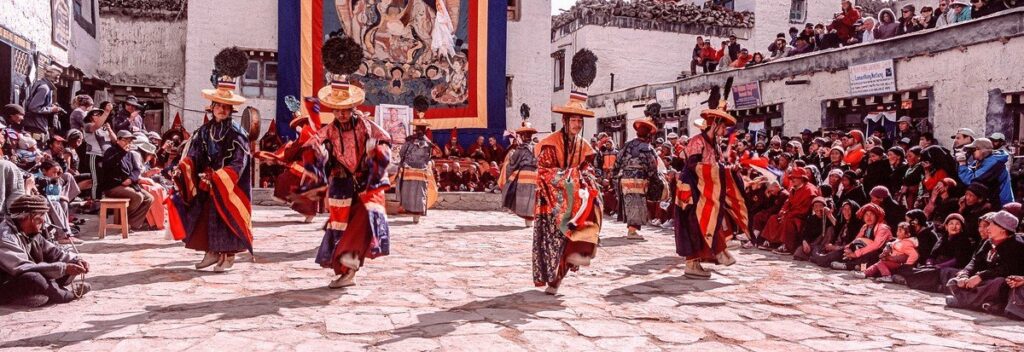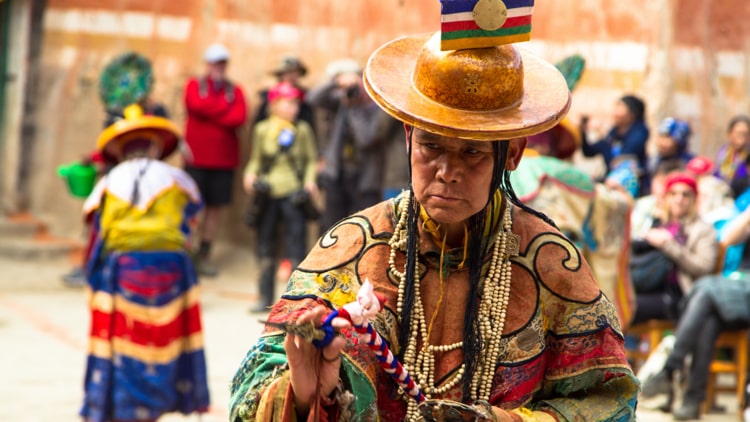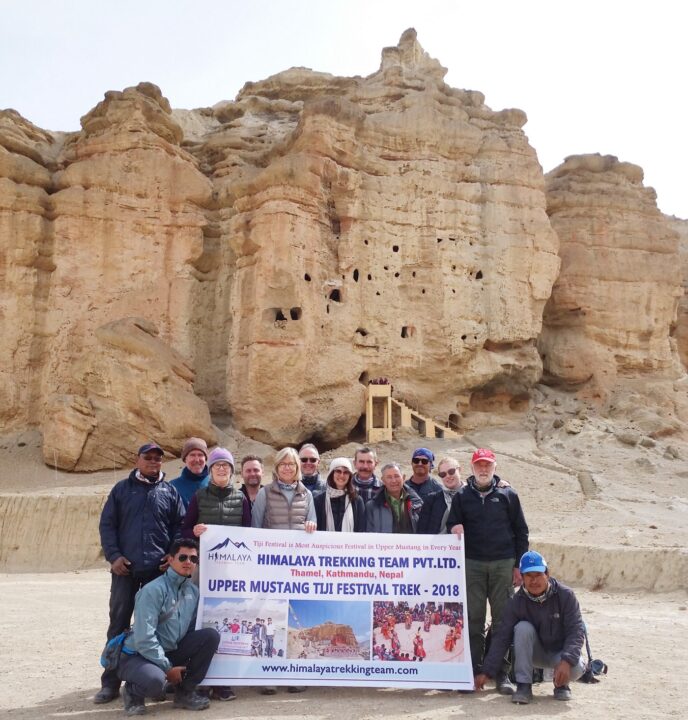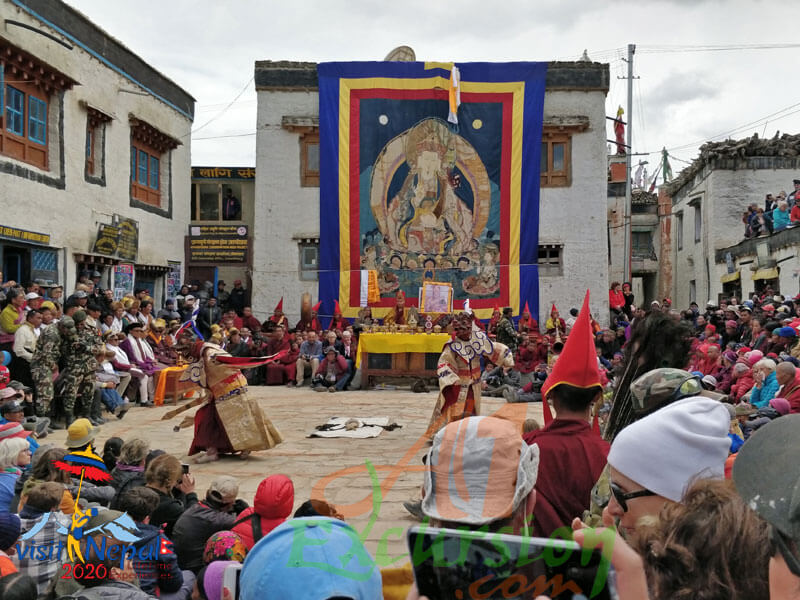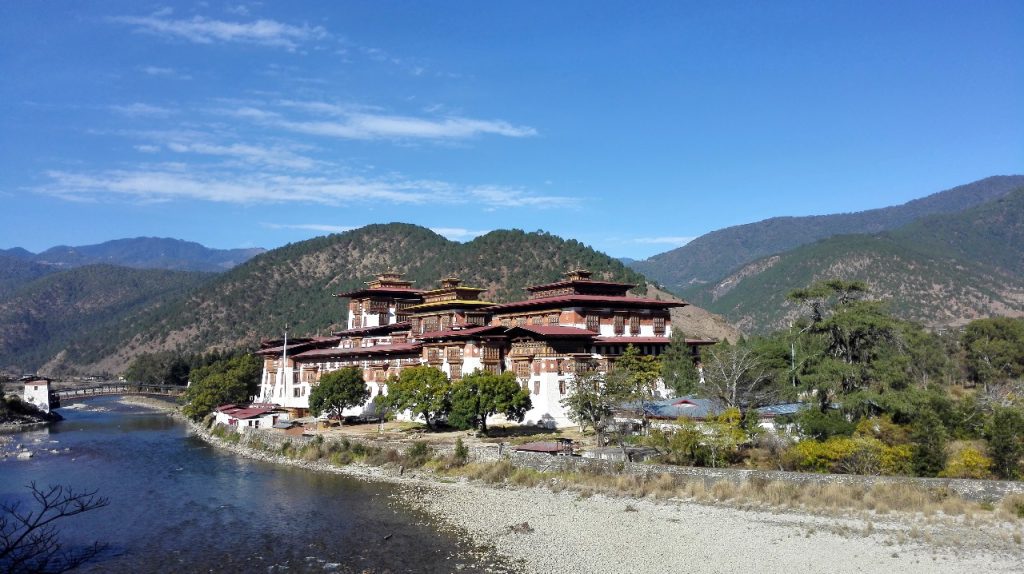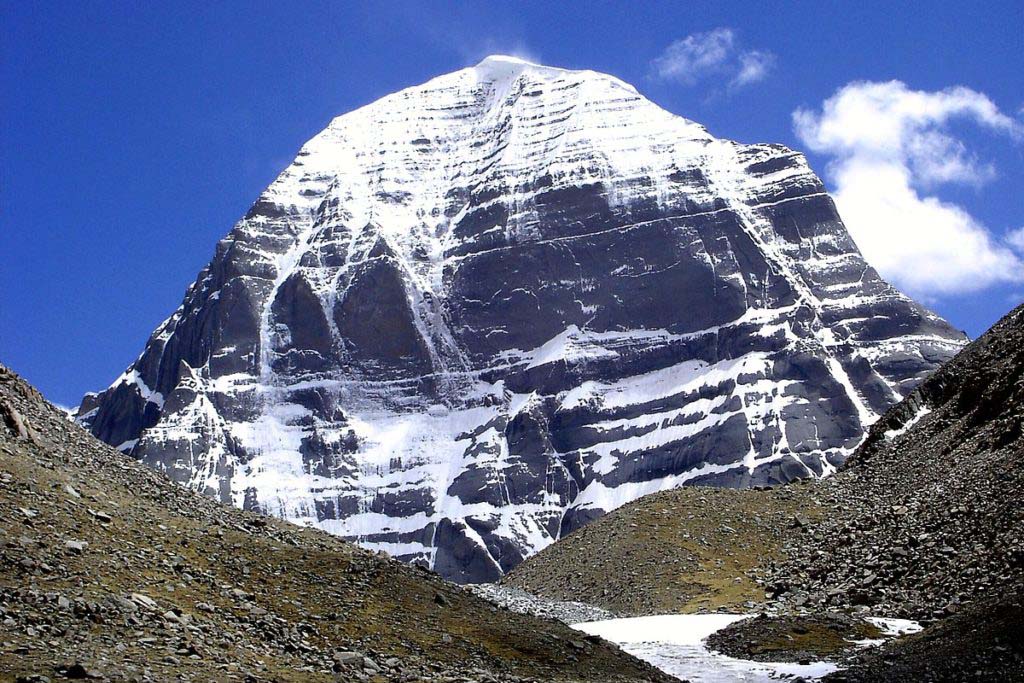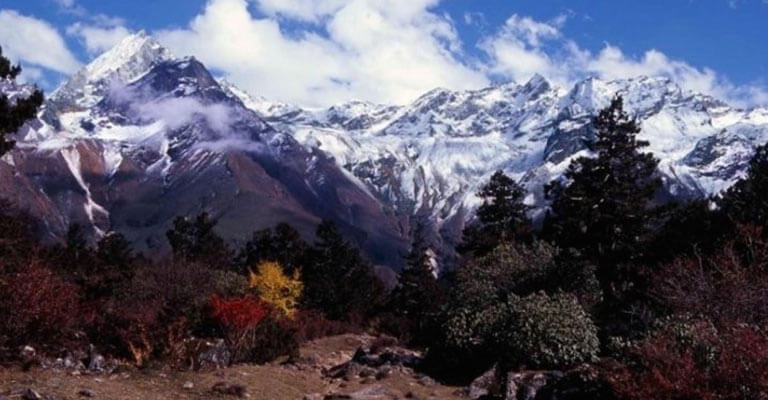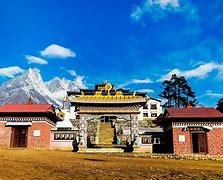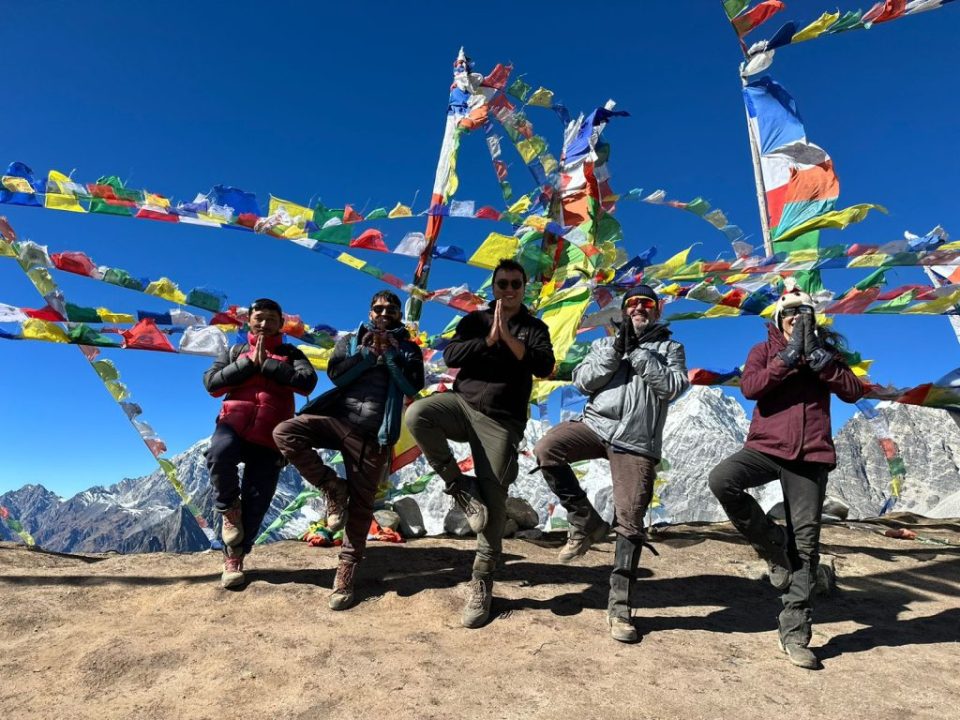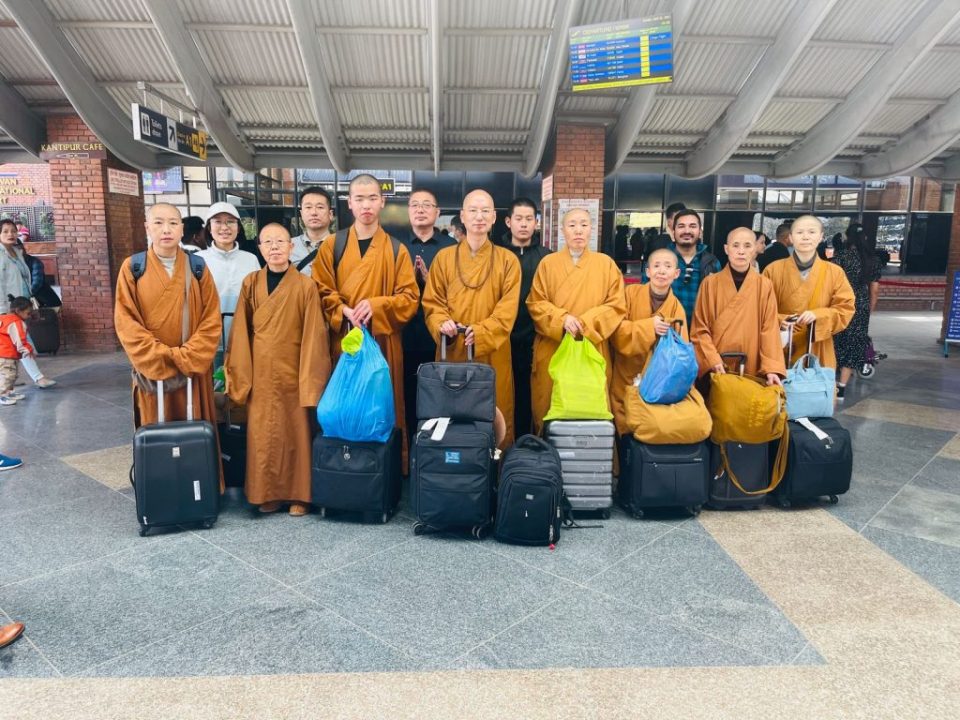Tiji Festival Trek
Trip Introduction
Lo Manthang, the hidden Kingdom of Upper Mustang, celebrates the appealing Tiji Festival for Three days annually. Tiji is a name derived from the word ‘Tempa Chirim,’ which means “World Peace Prayer.” This festival honors Lord Buddha’s incarnation Dorjee Sonnu’s victory against a demon known as Man Tam Ru, who preys on humans and causes storms and droughts. The celebration marks the start of the harvest season and is held in May. The festival began in the 17th century.
The main highlights of the trek include crossing the Trans Himalayas, exploring the ancient walled city of Lo Manthang, several monasteries, and gompas, and attending the Tiji Festival. During the festival, monks dress up in unique costumes and masks and perform rituals and dances to ward off evil spirits. The Choedhe Monastery, which belongs to the Sakya sect of Buddhism, organizes all of the festival dances.
The 16-day journey begins with a drive to the lakeside city of Pokhara. The journey will take between 6 and 7 hours. Fly to Jomsom, the Mustang district’s headquarters, the next day, and begin your journey to the Kagbeni from there. You will pass through the lovely villages of Chele, Syanbochen, Ghami, and Charang before arriving in the old city of Lo Manthang for the three-day Tiji festival. From there, we’ll travel through Dhakmar and Chhusang before descending to Jomsom.
Itinerary
Departure from : Kathmandu, Nepal
Arrival On : Kathmandu, Nepal
Day 1
Arrival at TIA Kathmandu
| Days | Activities | Duration |
| 1. | Arrival at TIA Kathmandu (1,400m/4,592ft) | |
| 2. | Fly to Pokhara (800m/2,625ft) – Fly to Jomsom (2,700m/8,856ft) and Trek to Kagbeni. (2,810m/9,217ft) | 3-4hrs |
| 3. | Trek from Kagbeni to Chele (3,050m/10,004ft) | 5-6hrs |
| 4. | Trek from Chele to Syanbochen (3,475m/11,398ft) | 6-7hrs |
| 5. | Trek from Syanbochen to Ghami (3,520m/11,546ft) | 5-6hrs |
| 6. | Trek from Ghami to Tsarang (3,620m/11,874ft) | 5-6hrs |
| 7. | Trek from Tsarang to Lo Manthang (3,730m/12,235ft) | 3-4hrs |
| 8. | Day-1 of Tiji Festival | |
| 9. | Day-2 of Tiji Festival | |
| 10. | Day-3 of Tiji Festival | |
| 11. | Trek from Lo Manthang to Dhakmar (3,810m/12,500ft) | 7-8hrs |
| 12. | Trek from Dhakmar to Syanbochen (3,475m/11,398ft) | 6-7hrs |
| 13. | Trek from Syanbochen to Chhusang (2,980m/9776ft) | 6-7hrs |
| 14. | Trek from Chhusang to Jomsom (2,720m/8,923ft) | 6-7hrs |
| 15. | Fly Back to Pokhara and Back to Kathmandu | |
| 16. | Departure. |
Upon arrival at Tribhuvan International Airport (TIA). Our agent will greet you and accompany you to the hotel. Drive to the hotel and check-in. Our guide will come to see you in the evening and give you a brief overview of the journey. At the hotel, we had dinner and stayed the night.
Day 2
Fly to Pokhara - Fly to Jomsom and Trek to Kagbeni.
Today you will enjoy an early morning breakfast at the hotel before departing for your morning flight to Pokhara. The flight lasts around 30 minutes. Taking the connecting flight, we will fly to Jomsom. The flight from Pokhara to Jomsom will take 20 to 22 minutes.
On arrival at Jomsom airport. The trek begins in Jomsom and ends in Kagbeni. The walk will last approximately 3 to 4 hours. We’ll stop for lunch on the way. We’ll walk down the dirt road that leads to Lower Mustang Kagbeni. Dinner and Overnight at the Teahouse.
Day 3
Trek from Kagbeni to Chele
We’ll leave for Chele after breakfast today. We will enter the upper Mustang restricted area. We will walk along the Kaligandaki River. We’ll eat our lunch on the way. We’ll be walking for about 5 to 6 hours. To get to Tangbe, we’ll have to climb several hills. From there, we’ll cross the Kali Gandaki River to get to Chele. Dinner and Overnight at the Teahouse.
Day 4
Trek from Chele to Syanbochen
We’ll leave for Syanbochen after breakfast today. Taklam La Pass and Dajori La Pass are two high passes that we will cross. We will be treated to breathtaking views of Tilicho and Damodar Danda. We’ll be walking for 6 to 7 hours. We’ll make our way down to Samar Village gradually. We’ll stop for lunch on the way. To get to Syanbochen, we’ll walk along the riverbank. Dinner and Overnight at the Teahouse.
Day 5
Trek from Syanbochen to Ghami
We’ll leave for Ghami after breakfast today. We will ascend the Kali Gandaki’s huge side valleys. We will ascend a hill to cross the Yamda La Pass. From there, we’ll make our way down to Gheling Village. We’ll stop for lunch on the way. We will travel through several villages and Chortens. In addition, we will cross the Nyi La Pass. The path then descends until we reach Ghami village. Dinner and Overnight at the Teahouse.
Day 6
Trek from Ghami to Tsarang
We’ll leave for Tsarang after breakfast today. We’ll descend to the valley via a slippery and rocky path. We will be trekking in the Mustang region’s dry zone. We’ll be crossing the Ghami Khola via the Suspension Bridge. We’ll stop for lunch on the way. We’ll be walking for 5 to 6 hours. We will then proceed to Tsarang village. Dinner and Overnight at the Teahouse.
Day 7
Trek from Tsarang to Lo Manthang
We’ll leave for Lo Manthang after breakfast today. Lo Manthang was once Lo’s capital. We’ll cross the river at the bottom and then climb up to Lo La Pass. We’ll stop for lunch on the way. We will have a spectacular view of mountains such as Annapurna, Nilgiri, Tilicho, and Bhrukti Peak. In Lo Manthang, you can visit ancient temples and monasteries. Dinner and Overnight at the Teahouse.
Day 8
Day-1 of Tiji Festival
Today marks the start of the Tiji Festival. The festival will be held at Lo Manthang’s Royal Palace. The festival will begin with a Thanka painting of Padma Sambhava or Guru Rimpoche. We will be treated to a variety of performances by monks from Chhode Monastery. You will have the opportunity to observe their tradition. We see people dressed in their traditional attire. We will enjoy the Tsa Chhama dance performance, which portrays the story of Tiji and the victory of Dorjee Sonam, the reincarnation of Lord Buddha, over the demon. Dinner and Overnight at the Teahouse.
Day 9
Day-2 of Tiji Festival
Today, after breakfast, we will return to Tiji Festival for the second day. We will proceed to The Royal Palace, where we will find a large crowd of locals and tourists. We will enjoy the dance of Tibetan lamas dressed in various costumes. The dance performance will continue as the second part of the story begins, in which Dorjee Sonam portrays the demon’s shift into the Buddha’s realm. Dinner and Overnight at the Teahouse.
Day 10
Day-3 of Tiji Festival
Today is the last day of the Tiji Festival; after breakfast, we will proceed to the Royal Palace. Dorjee Sonam will be victorious in the final chapter of the story. This portrays the demon’s exile from Mustang. The performance conveyed a positive message to the audience. Dinner and Overnight at the Teahouse.
Day 11
Trek from Lo Manthang to Dhakmar
We’ll leave for Dhakmar after breakfast today. We’ll be walking for 6 to 7 hours. The trail crosses through the high mountains and gorge. We’ll go to the Gargen Chyoling Nunnery, where it’s said the demon was killed the same night the monastery was built. We’ll stop for lunch on the way. In Gyakar village, we will also visit the Old Ghar Gompa. We will descend to Dhakmar village along a trail that offers breathtaking views of the mountains. Dinner and Overnight at the Teahouse
Day 12
Trek from Dhakmar to Syanbochen
We’ll leave for Shyanbochen after breakfast today. We’ll be walking for 6 to 7 hours. We’ll take the same path we took to get to Lo Manthang. We’ll climb up the hill first, then descend to reach Akaima. We’ll travel across the dry Plateau and through the fields to Ghiling Village. We’ll stop for lunch on the way. We will descend through barley fields and small streams to reach Shyanbochen. Dinner and Overnight at the Teahouse.
Day 13
Trek from Syanbochen to Chhusang
We’ll leave for Chhusang after breakfast today. We’ll be on the road for 6 to 7 hours. To get to Chhusang, we’ll follow the Mustang Khola. On the way, we’ll stop by the Chungsi Cave Monastery. We’ll eat our lunch on the way. We’ll enjoy the trail because the cliffs are red-orange and silver-grey. We’ll continue on our way to Chhusang village. Dinner and Overnight at the Teahouse.
Day 14
Trek from Chhusang to Jomsom
We’ll leave for Jomsom after breakfast today. We’ll be walking for 6 to 7 hours. We’ll go for a walk along the Kaligandaki River. We will take in the breathtaking view of the mountains. We’ll have lunch in Kagbeni. We’ll leave the upper Mustang trail and head back to Jomsom, our starting point for the trek. Dinner and Overnight at the Teahouse.
Day 15
Fly Back to Pokhara and Back to Kathmandu
Today, after breakfast in Jomsom, we will fly back to Pokhara. After landing in Pokhara, we will explore the Lakeside and enjoy your lunch. After lunch, drive to the airport to fly back to Kathmandu. On arrival, you will be transferred to the hotel. The rest of the time is yours. Stroll around Kathmandu city on your last day at Kathmandu or just rest in the hotel.
Day 16
Departure
The 15-day journey has concluded. Today is your last day in Kathmandu. Our representative will have a short discussion on the trip and take your feedback after a hearty breakfast. Following this session, we will drive you to the airport in our private transportation 3 hours before your flight.
Route Map
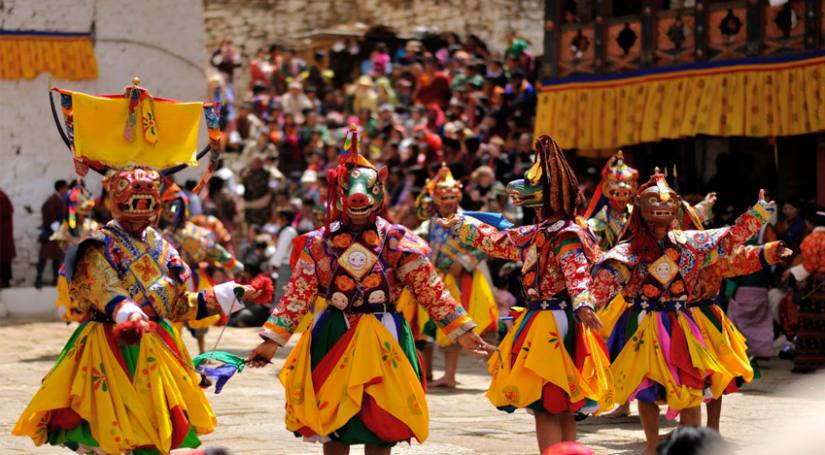
Altitude Map
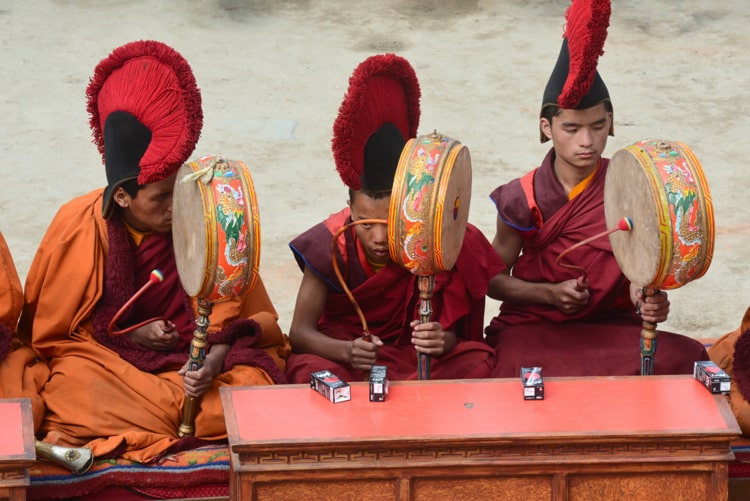
What's Included
- Arrival & Departure: Airport – Hotel transfer – Airport (Pick Up and Drop on private basis).
- Hotel Accommodation in Kathmandu: 2nights at Star categories hotel on twin sharing on bed and breakfast basis.
- Welcome Dinner and farewell dinner at Nepali culture restaurant in Kathmandu.
- Food & Lodging: 3 meals a day (Breakfast, Lunch, Dinner) along with accessible accommodation sharing during the trek.
- Permit: All necessary paper works: ACAP Permit, Upper Mustang Restricted Area permit, and TIMS Card.
- All government and local taxes if necessary.
- Trekking Map: Upper Mustang Trekking map.
- Member transportation: – Air Transportation: Flight from Kathmandu – Pokhara, Pokhara to Jomsom and while returning.
- Drinking: 2 liters of boiled water to carry on thermos per day per member.
- Guide: Government licensed Guide (English speaking) during the trek
- Porter: Porters (2 trekkers: 1 porter) up to 15kg during the trek.
- Insurance: Insurance for all involved Nepalese staff during the trek.
- Comprehensive Medical kit.
What's Not Included
- Air Fare: International flight airfare (from and to Kathmandu).
- Nepal Tourist Visa fee.
- Extra night in Kathmandu: Extra nights’ accommodation in Kathmandu. In case of early arrival or late departure, early return from Trekking (due to any reason) than the scheduled itinerary.
- Personal Insurance: Travel and high-altitude insurance, accident, Helicopter medical & emergency evacuation. *Mandatory
- Personal Expenses: Telephone calls, Internet, Toiletries, battery recharge, hot shower, laundry, soft drinks, beer, and any alcoholic beverages.
- Personal Equipment: Clothing, Packing Items or Bags, Personal Medical Kit, Personal Trekking equipment.
- Rescue Evacuation: Medical and emergency rescue evacuation costs if required. (Rescue, Repatriation, Helicopter, Medication, Medical Tests and Hospitalization costs).
Equipment List
What to bring ?
General
Tailor Your Holiday
Everyone has their own preferences in terms of destination, journey time, and budget. As a result, sticking to our plan isn't necessary. We will create a personalized itinerary for you that includes accommodations, transportation, meals, and tour guides. We guarantee you the best Tailor-made Package because this is your trip. You have the option to personalize it, as your liking. Let us Plan together to make your Vacation worth it.
Fixed Departure
Why Travel With Us?
Secure Online Payment, No Credit Card Fee
Travel with Locals. Support Locals
Lifetime Deposit
Private & Tailor-Made Trips
24/7 International Support
Support Local Communities & Donate to Charity
All Inclusive Price
Secure Online Payment, No Credit Card Fee
Trip Facts
| Country | Nepal |
| Duration | 16 Days |
| Maximum Altitude | 4,010m/13,156ft |
| Region | Mustang |
| Meals | Breakfast, Lunch, Dinner |
| Accommodation | Hotel, Lodge, Teahouses |
| Grade | Challenging |
| Best season | Mar, Apr, May, Sep, Oct, Nov |
Trip Highlights
- Scenic Flight to Jomsom.
- Explore the ancient Buddhist Kingdom Lo Manthang.
- Visit the Unique Caves, ancient Monasteries and Gumbas.
- Explore the ancient Buddhist Culture.
- Enjoy the amazing views of Mt. Annapurna, Mt. Dhaulagiri, and Mt. Nigiri.
- Trek through the world’s deepest Gorge. The Kali Gandaki River Gorge.
Is this trek appropriate for you?
- The Upper Mustang Tiji Festival Trek is the Moderate Trek. You can easily complete this trek if you are physically and mentally prepared and willing to do so.
- You will be Trekking for 10 Days. The Path can be completed in as little as 3 hours as much as 7 hours.
- The walk is not tricky, there is no Climbing or Scrambling but the path is rocky and hilly.
- Each day you will cover 200 to 400 meters in height while trekking. The highest point in the trek you will reach on the trek is 4,010m.
- The weather and Remoteness of this trek, as well as dealing with the high altitude, require a slow pace and the need to stay hydrated.
The ideal season to travel
Spring (March, April, May):
Spring is the finest time to trek in the Upper Mustang region after autumn. You will enjoy the long, warm days of this season. The weather will be warmer, and the river will be full of snowmelt in the lower region. The trail will be vibrant this season because it is Rhododendron season. Along the journey, you’ll see some wildflowers. The temperature ranges from 16 to 22 degrees Celsius.
Summer (June, July, August):
The hottest month of the summer, as well as the beginning of the monsoon season. The temperature ranges from 16 to 20 degrees Celsius. Because Upper Mustang is dry, there is very little chance of monsoon. It is safe to trek during the monsoon season. However, you must take precautions because the monsoon will affect the lower region, making the path slippery and the possibility of landslides.
Autumn (September, October, November):
Autumn is the best season for trekking because the skies are clear and blue. You will have the best trekking memories if the temperatures are bearable and the weather is stable. The rainfall is low during this season, and the scenery is stunning. The temperature ranges from 12 to 20 degrees Celsius.
Winter (December, January, February):
December to February is the winter season. The nights, on the other hand, are much colder, with temperatures dipping below zero degrees. If you go trekking during this season, you will discover that it is less crowded, but you will have to struggle with the snowfall. While trekking, you must proceed with caution.
Flight to Jomsom
- Almost every trip begins with a flight from Kathmandu to Pokhara and from Pokhara to Jomsom Airport. As it is the easiest way for your trek to the Upper Mustang.
- Pokhara is 159 kilometers from Jomsom Airport. The domestic airport of Jomsom is located in Jomsom, Mustang District.
- The airport is located at a height of 2,736meters above sea level. It only has one runway.
- The flying time is around 20-22 minutes. During the monsoon season, flights are frequently delayed or canceled.
- The flight only operates from Pokhara airport.
Altitude sickness
Beyond 2,500m (8,000ft), Altitude sickness is a sneaky monster that may attack even the fittest trekkers. These demands do everything in your power to prepare for altitude trekking and take things carefully throughout your Upper Mustang journey. With increasing altitude, the amount of available oxygen decreases, which is the primary cause of high-altitude sickness.
So, you may suffer from different altitude sickness in the altitude of i.e., Acute Mountain sickness (AMS), High pulmonary edema (HAPE), and High-altitude cerebral edema.
Your body requires time to adjust to thin air, so start at a lower altitude and work your way up. Some of the symptoms of Altitude sickness are:
- Increased breathing.
- Increased urination.
- Restless sleep.
- Periodic breathing at night because of altitude.
- Shortness of breath.
- Extreme fatigue.
- Respiratory failure.
- Cerebral edema.
Certain care should be made to ensure that the situation does not worsen. However, if the symptoms worsen, you may need to return to a lower height and seek medical help. There are, however, several other precautions you may take while trekking to lessen your risk of altitude sickness.
- Trekkers can modify their bodies by slowly and gradually climbing, as our bodies require time to adjust to the oxygen level. For high altitude trekking, at least one day of acclimatization rest is essential, and you should ascend as high as possible before returning to a lower altitude for the night.
- You should do various strength training exercises such as running, cycling, jogging, push-ups, and going to the gym to acquire strength and stamina for your adventure.
- As the air gets increasingly thin, an increase in elevation reduces oxygen levels, and in the Everest region trek, an increase in altitude also means less vegetation. The consumption of alcoholic beverages, cigarettes, and tobacco decreases the body’s water content.
- The greatest remedy is to always stay hydrated. On your walk, instead of drinking cooled water, drink warm water.
- Diamox is the most effective altitude sickness medication; thus, you should bring a subscription with you on the trek. However, you should consult with your physician to see whether it is advantageous.
Things to know before traveling to Upper Mustang.
Drinking-Water in Upper Mustang.
Upper Mustang is a hot, dry, and dusty area, so trekkers must hydrate their bodies at a higher altitude than in lower elevations to avoid dehydration and altitude sickness. Lack of fluid can be the main hindrance during the trek. You should hydrate your body with at least 3-4 liters of water daily (Tea, soup, or normal drinking water).
Upper Mustang is a semi-desert region. There is very limited stream water in the trail to Upper Mustang. Stream water far from the human settlement might be safe to drink, but we recommend you not to have it without purifying. Every village along the trail has one public drinking water tap. You can fill your bottle and drink after purifying it.
Besides that, the other places to get drinking water are local teahouses/guesthouses and lodges, but it is also unsafe to drink without being purified or boiled. The teahouse also provides boiled drinking water. Coldwater is provided free of charge, but for boiled water, you have to pay a certain amount. Bottled water is also available in Upper Mustang. It cost around 1$-2$ per bottle.
Every day, you must carry enough water for the day before beginning the trek because in someplace you won’t find any water resources on the trail i.e., Yara and Tangge.
We recommend you bring a Reusable water bottle of 2-3ltr or water pouch favorable for both hot and cold water.
Here are some ways that you can use to make the water drinkable.
- Boiled water
Boiling water is the best way to purify the water. As we are climbing to a higher altitude you need to boil the water for about 3-minute and season it with a pinch of salt before drinking. You can get free tap water in the teahouse/guesthouses but for boiled water, it cost a certain amount.
- Purification tablets or electrolyte powder.
Purification tablets like chlorine or iodine tablets are commonly used tablets by trekkers to disinfect the water. 1 tablet is enough for a liter of water. It takes around 30 min for the tablets to dissolve and become drinkable. Water, purified by tablets may leave a taste in your mouth.
Electrolyte powder is another option. Electrolyte powder is a better way to purify water than tablets because electrolyte powder contains minerals such as salt, Potassium, Magnesium, which are important for your body during the trek.
- UV Light water purifier/ SteriPEN.
It is a simple, effective, economic, and environment-friendly way to purify water. It kills the bacteria and virus within 10 sec by exposing them to ultraviolet light using Steripen, without changing the flavor of the water. This is a highly recommended means of purifying water.
Electricity and Internet facility at Upper Mustang.
Electricity facility.
Upper Mustang doesn’t have hydro-powered electricity. They still rely on solar panels or solar power battery/generator electricity that is enough to light the bulbs and charge small devices. There will be no charging socket in your room. You might be able to charge a normal mobile set, camera battery, and power bank from the solar power battery/generator which is also limited to certain times of day (usually in the evening). The solar battery might harm your device, so you have to charge it at your own risk. As a result, it is recommended that you bring a power bank and spare camera batteries that will last the duration of your trek.
Internet Facility and Network Service
Upper Mustang has internet access, but it is not reliable. Few Guesthouses in Upper Mustang have Wi-Fi Via. Satellite connection, but it only connects like once in a blue moon. It will cost you around 10$ for 24 hours and also won’t function properly. So, just assume that there is no Internet connectivity in Upper Mustang.
NTC mobile service works ok in Upper Mustang, but as usual, it only works when you are within the coverage of signal. In some places, there is no NTC coverage. During that time, you will be disconnected from your dear ones. Buy the 4G NTC sim card from the stores in Kathmandu for 1$. By taking data packages from NTC you can access the internet, only when the mobile network catches a signal. It is not guaranteed that your mobile network will have a signal all the time. Or you can buy a satellite phone.
| Buy NTC data package
Dial*1415# |
Cost of data package in NTC:
-14GB=7$ (Valid up to 28days -30GB=15$ (Valid up to 90 days) |
Check balance
Dial *1415# |
Document needed to buy a sim card.
For Foreigner = 1 passport size photo, Passport photocopy, or valid identity card.
For Nepali = 1 Passport size Photo, Photocopy of Citizenship.
Some useful tips to avoid the problem of No electricity.
- Extra batteries for the camera.
- Power bank with 5000-10000mAh.
- The solar charger and solar lamp (LuminAID Nepal lamp)
- As possible less usage of a device with low brightness, GPS, and airplane mode.
Essential Backpack items for Tiji Festival Trek.
The bag of a trekker also reveals the trekker’s level of experience. A good trekker should be a smart backpacker. You should be pre-prepared for the things that you need in the trek. As this trek is in an isolated area, there won’t be any shops once you start your trek, so need to bring enough supplies that you need in the trek.
Here are some of the things that you need to take with you for the trek.
Travel documents
- Airline tickets with the itinerary.
- Travel insurance policy documents.
- Original valid passport.
- Copies of passport.
- Passport-sized photos.
- Nepalese cash.
- Travel permits.
Clothing
- A pair of waterproof trekking shoes or hiking boots.
- A pair of flip flop slippers or running shoes.
- 2-3 sets of thermals (leggings and tops)
- 4-5 pairs of hiking long sleeve shirts or tops.
- Pairs of hiking shorts and pants.
- Fleece jumpers or a set of tracksuits.
- Good quality windproof down jacket.
- Lightweight waterproof rain jacket and pants.
- Neck gaiter, leg warmer, and packet of pocket hand warmers.
- 5-6 pairs of quick-dry socks, underwear, sports bra.
- Pair of inner and outer gloves.
- Knitted Hat, sun cap, beanie, or bandana.
- Glacier Sunglasses and eyeshade.
Trekking equipment
- Waterproof trekking bag of 40-50liter and Rucksack of duffel bag (if your backpack is not enough for all your item and need a potter).
- Reusable water bottle (both hot and cold) of at least 2-3litre.
- A sleeping bag and sleeping bag liner.
- Trekking stick/ poles.
- Route Map of Upper Mustang.
- Crampons (if you are trekking in the Winter season, Dec-Feb).
- LED Headtorch or solar lamp (LuminAID Nepal lamp is best as it is solar-charged and very much portable)
- Stuff sacks, paper bags.
- Plug adapter, Charging appliances, Power bank, Camera batteries.
- Pocket knife.
- Travel Wallet.
Toiletries
- Rolls of Toilet paper, wet wipes, and tissue.
- Medium-sized quick-drying towel.
- Toothbrush and toothpaste.
- Hand sanitizer.
- Sunscreen, lip balm, body lotions.
- Portable mirror.
- Shampoo and soap.
Personal First Aid Kit
- Antibiotics
- Painkillers, Paracetamol, ibuprofen, aspirin, Nicole
- Sanitary pads
- Anti-inflammatory spray.
- Anti-Nausea tablets.
- Anti-diarrhea pills or power.
- Altitude sickness tablets- Diamox
- Water purifying tablets or electrolyte powder.
- Mosquito and Insect Repellent.
- Earplugs
You can buy or hire trekking clothes and equipment in Thamel, Kathmandu. If you are buying it, you have to allow an extra day for shopping; however, if you are hiring it, you must inform us in advance so that we can arrange it before you arrive in Kathmandu. This way you can reduce the weight of your luggage and save time and money.
Branded trekking clothes and equipment are available around the Thamel area at a reasonable price.
Accommodation, Meal, and Transportation
Accommodation
We will accommodate in star hotel during our stay in Kathmandu.
In Kagbeni, Chhusang, Jomsom, and Muktinath we will stay in Basis Hotel or Lodges.
The rest of the place we will accommodate in basic Lodges or Teahouses/ Guesthouses.
Meal
During the trek, we will provide you three-time meals. You can choose from the given menu.
Breakfast– Tibetan Bread/ Chapatis, Buckwheat Roti, Pancakes, Boiled egg, omelets, Boiled potato, Tsampa porridge, Yak Butter Tea, Masala Tea, Lemon Ginger tea, Hot chocolate, etc.
Lunch– Dal Bhat set (Rice, Vegetable curry/ Meat curry, Lentils, Pickle, Cucumber Salad, Papad), Thukpa-Tibetan Noodle soup, Garlic soup, Fried noodles/ Chowmein, Mo; Mo (dumplings), Potato fries, Pasta, Fried Rice, etc.
Dinner-Dal Bhat set (Rice, Vegetable curry/ Meat curry, Lentils, Pickle, Cucumber Salad, Papad), Thukpa-Tibetan Noodle soup, Garlic soup, Fried noodles/ Chowmein, Mo; Mo (dumplings), Potato fries, Pasta, Fried Rice, etc.
These are the options of food that you will find mostly on the trek to Upper Mustang.
Transportation
By Bus- From Kathmandu airport to hotel at Kathmandu and vice-versa.
By Air– Flight from Kathmandu to Pokhara, Pokhara to Jomson and returning.
Guide and Staff Arrangements
Throughout the trek, all your activities will be handled by our well-qualified and professional staff. They will do all the escorting. As this is one of the hardest and tricky treks, we are providing you with a highly experienced and licensed guide with fluent English speaking and has excellent navigation and technique of rope fixing skills. They will accompany you from Kathmandu and guide you during the whole journey to Upper Mustang- Tiji Festival. They will explain all the rituals done by the monks in the festival and help you to know fully about the importance of this festival. Each group of 4-5 trekkers will be assigned an assistant guide, as well as a porter for two trekkers (2*15kg =30kg). If your luggage weighs more than 15kg you will be provided a porter individually but you will be charged for 2 people.
All our lead guides, assistant guides, and potters are well professional and experienced. So, we hope for your respect and cooperation with them throughout the trek.
A typical day on the Tiji Festival Trek
Every day will begin with the ringing of your alarm clock at 6 a.m. and a knock on your door from your guide with the invitation of breakfast. Get up, have Tibetan breakfast, pack your backpack and get ready to start your day’s walk by 7 a.m. We need to start our trek early to avoid the scorching sun and in the midafternoon the wind gets stronger compared to the morning at higher altitudes.
You’ll walk along the dusty and rocky trail accompanied by the views of the semi-deserted landscapes, passes; clicking photos; creating memories; interacting with your guide; hearing each other’s stories. Lunch will be served at a local teahouse/guesthouse in the afternoon. Having the flavorful Dal Bhat and an hour of rest, we will proceed to the day’s final destination as per the itinerary.
On arrival at the destination, check into your accommodation. Get freshen up and some rest. As every teahouse/lodge/guesthouse where we stay has a common dining area with a heater, there you will get to meet other travelers. You can sit there, laugh at each other stories, play cards, sing songs, play music, and have a good time. This will help you forget all the tiredness of the day. Later in the evening, you will have your dinner together. After dinner, your guide will give some short briefings about the next day’s trek regarding when you must get up, when we have to start our trek the next day, where we will stay the next day, how many hours we have to walk and so on.
During this trek, you will walk for a minimum of 4 hrs to a maximum of 8hrs in a day. You will have 2 scenic flights before starting and ending your trek. You will walk over the dry trail of semi-deserted land and passes. During this trek, you will experience/live the typical lifestyle of ancient Tibetans, which has been undisturbed until now. You will walk through the traditionally built houses (roofs stacked with woods, wall painted with white color, bright color small windows, small and cold from the outside but warm and welcoming from inside), world’s deepest gorge.
During the Tiji Festival in Lo Manthang’s Royal Palace, you will be the audience. You will get to see the ancient Thangka of Guru Rinpoche over the building. Admire the masked dance and chants done by the lead monk from Chode Monastery, wearing colorful costumes, portraying the legend- Dorje Sonnu defeating the demos to save the land from drought. The story of the Dorje Sonnu will be shown in part-part within these 3 days. Absorbing the rituals done by the monks the Tiji festival celebration ends. Admiring the view of Mt. Annapurna, Mt. Dhaulagiri, and Mt Nigiri over the semi-deserted rocky landscapes, walking in the dry trail you will complete the trek. Every stop along the way will be a wonderful day. When you leave the Mustang village, you may feel some emptiness in your heart. Your hard walk will be rewarded with the wonderful experience of the Tiji Festival and lifelong memories.
Nepal Tourist Visa and permits details
Visa procedure.
To travel to Nepal, you’ll need a tourist visa that is valid for the period of your stay in Nepal. Better, if you have a tourist visa valid for at least 1 month because anything can happen during the trip, and staying in Nepal after your visa expires would result in you paying a penalty. Apply for a visa at your nearest Embassy of Nepal or obtain an On-Arrival visa at immigration in Tribhuvan International Airport, Kathmandu. But it’s better to contact your nearest Nepalese Embassy.
Here are the documents that you need, to apply for the tourist visa.
- The Tourist Visa Application Form for Nepal (Fully completed online and printed)
- Original Passport with at least 2 blank pages and validity of at least 6 months.
- Photocopies of your passport’s information page.
- At least 2 recent passport-sized photos of yourself with white background.
- Proof of accommodation in Nepal.
- Valid travel and return flight tickets.
- A bank statement from the last 3 months with a minimum closing balance of NPR2,00,000.
- Receipt of the visa fee for Nepal.
Note 15 days visa costs USD 30. But our trip is for 16 days so apply for 30 days tourist visa, which costs USD 50. For 90 days visa costs USD125.
Entry permits and Requirements
Upper Mustang is the restricted area of Nepal so you have to obtain some special permits to trek to Upper Mustang. The Entry permits that you need for the trekking to Upper Mustang are;
| Trekking permits | Foreign Nationals | SAARC nationals | Nepali Citizens | |
| 1. | Upper Mustang Restricted Area permit (Upper Mustang RAP) | USD 500 per person for the first 10 days.
Additional USD 50 per day per person beyond 10 days. |
USD 500 per person for the first 10 days.
Additional USD 50 per day per person beyond 10 days. |
-N/A |
| 2. | Annapurna Conservation Area Project permit.
(ACAP entry permit) |
NPR 3,000 per person | NPR 1,000 per person | NPR 100 per person per entry |
| 3. | Trekker’s Information Management System
(TIMS Card) |
NPR 1,000 per person with a guide (GT) | NPR 300 per person with a guide (GT) | -N/A |
Note-Upper Mustang Restricted Area Permit has to be issued from the Department of Immigration of Nepal, Kalikastha, Dill Bazar, Kathmandu. The permits will be ready within 2-3 hrs after the submission of documents.
Annapurna Conservation Area Permit can be issued from Nepal Tourism Board, Bhirkuti Mandap, Kathmandu, or Tourist Information Centre, Pokhara. But to save time get the ACAP Permit and TIMS Card from Nepal Tourism Board, Bhirkuti Mandap, Kathmandu.
You cannot travel alone in the restricted area- Upper Mustang, so to issue Upper Mustang Restricted Area Permit as well as TIMS Card, you need to apply from a local registered trekking agency with at least 2 members, accompanied by a licensed guide.
For more information about TIMS Card and Restricted Area Permit here is the link.
(If you are traveling from a travel/trekking agency your agency will arrange all the Permits.)
Documents required to get these permits.
- Complete the permit form with your passport details and tour details (Trekking area, Entry and Exit date, and point, Route of Trekking, Emergency contact information for Nepal and your Home country).
- Passport size photos.
- Original passport with a valid visa
- Photocopies of passport personal information page.
- Copy of Travel Insurance policy to obtain TIMS card.
For Upper Mustang Restriction Area Permit.
- A letter of guarantee from the tour operator.
- Letter from TAAN.
- Copy of your International flight ticket itinerary (Date of arrival in Nepal) and Trek itinerary.
- Copy of TIMS Card and ACAP permit.
- Copy of Company Registration Certificate, Tax Clearance Certificate, PAN Registration Certificate of the trekking company.
Travel Insurance
During the journey, you may encounter several unexpected incidents or losses. Trekking in Nepal is an adventurous and occasionally dangerous activity, especially at high altitudes. Trekkers must have travel insurance before visiting Nepal for trekking. During this 12-days trek to Upper Mustang, you may encounter a physical injury, illness, or an unexpected accident, and you will be responsible for all medical expenses and losses.
Choose an insurance policy that covers all of your possible risks from the start of your journey to your final destination. The following threats should be covered by your travel insurance:
- Cancellation of Domestic and International flights.
- Lost and stolen baggage and passport.
- Hospital and Medical expenses (physical injury, Acute Mountain sickness, Altitude sickness, sudden accident)
- Emergency rescue such as Helicopter.
- All high-altitude trek dangers up to 4,500m.
You need to choose your travel insurance wisely so that, in the case of such an incident, your travel insurance will cover the costs.
You can get your travel insurance in either your home country or in Nepal.
Responsible Travel
Upper Mustang is a restricted area of Nepal. The village in Upper Mustang is isolated and soaked in Buddhist Tibetan culture, tradition, and lifestyle which is completely different and unique from others. You will be able to experience the typical lifestyle of Buddhist Tibetans as well as their Lopas, Nyingma, Kagyo, and Bon culture, which have been practiced from many years ago. Upper Mustang- Lo Manthang is the main tourist destination because it is the hidden ancient Buddhist Kingdom of Mustang. It has been protected from mass tourism by the locals.
So, you have to respect the local people, their local culture and tradition as well as nature and environment. You can help them by using local products and services. You can learn some greetings words to greet them respectfully. For example, “Tashi Delek” means Goodluck/Blessings. While walking along the road and off-road dusty trail, you must maintain a peaceful attitude. We expect you to properly dispose of your plastic garbage (food wrappers, plastic water bottles) while traveling.
Upper Mustang is a restricted area, so be a responsible traveler and obtain the permits from the Nepalese government before trekking to Upper Mustang. Upper Mustang is a remote trekking destination, so the infrastructure in this area is not much developed. Your one small negative activity can make a big impact on them and their daily life.
Your responsible travel will help Nepal achieve long-term sustainable tourism.
FAQ’s
Why to do Tiji Festival Trek?
The Upper Mustang Tiji Festival trek is an adventurous trek to the hidden gem of Nepal. The villages in the Upper mustang are isolated and heavily soaked in the ancient Buddhist Tibetan culture. You will have lots of fun, adventure, and get to experience a lot i.e., Wide angle view of white Himalayans, semi-deserted rocky landscapes, typical Sherpa- Tibetan’s villages, Undisturbed Bon culture, delightful Tibetan cuisine, and so on. If you want to have an adventure as well as experience a different culture different from yours, this trek is for you. This trek is a combined package of cultural and adventurous trekking.
In how many days can we complete Tiji Festival Trek?
The Upper Mustang trek can be completed in as short as 12 days to long as 15 days.
When is the best time to do Tiji Festival Trek?
Spring season (March- April- May) is the best time to do the Upper Mustang trek. Spring is the season after the monsoon. Due to the weather being warm and stable, the sky gets clear and fresh and you will get to see the alluring view of the landscape and snow-covered mountains.
- Will I gain AMS during the Upper Mustang trek, even if am a frequent trekker?
Acute Mountain sickness is the sneaky monster that sometimes attacks even the fittest trekkers beyond 2,500m (8,000ft). So, you can gain AMS during the Upper Mustang trek.
Even if you are a frequent trekker, sooner or later depending on your health condition and your previous trek altitude history, you might gain AMS. You might gain AMS much later than other newbie trekkers. So, you have to balance everything to make your body able to tackle altitude sickness. For that, you have to intake a sufficient amount of liquid and if needed acclimatize properly.
What is the available infrastructure for the Upper Mustang trek?
Transportation– To do the Upper Mustang trek you have to take 2 flights. From Kathmandu airport to Pokhara and Pokhara to Jomsom, which is the starting point of the trek.
Drinking water– There is very limited stream water in the Upper mustang. But there is a communal water tap in every village of Upper Mustang but you can’t drink it without purifying.
Besides that, the other places to get drinking water are local teahouses/ guesthouses and lodges, but it is also unsafe to drink without being purified or boiled. The teahouse sells boiled drinking water. Coldwater is provided free of charge in teahouses, but for boiled water, you have to pay a certain amount.
Accommodation– During your whole trek to Upper Mustang you have to accommodate in either basis lodges or teahouses or guesthouses.
Foods– You will get local food during this trek. The type of food you will find in this trek is-
For Breakfast– Tibetan Bread/ Chapatis, Buckwheat Roti, Pancakes, Boiled egg, omelets, Boiled potato, Tsampa porridge, Yak Butter Tea, Masala Tea, Lemon Ginger tea, Hot chocolate, etc.
For Lunch and Dinner– Dal Bhat set (Rice, Vegetable curry/ Meat curry, Lentils, Pickle, Cucumber Salad, Papad), Thukpa-Tibetan Noodle soup, Garlic soup, Fried noodles/ Chowmein, Mo; Mo (dumplings), Potato fries, Pasta, Fried Rice, etc.
Electricity/ Network/ Internet – There is no access to electricity. The entire village relies on solar panel electricity and solar power battery, which is enough to light bulbs and charge small devices. 4G NTC cellular service is available in Upper Mustang, but it might not work until you are within its coverage. You can use a satellite phone. Upper mustang does not have reliable Internet connectivity.
What permits are required for Tiji Festival Trek?
Upper Mustang Restricted Area Permit, Annapurna Conservation Area Project Permit, and TIMS Card are required for Upper Mustang trek.
Upper Mustang RAP costs USD 500 per person for the first 10 days and an Additional USD 50 per day per person beyond 10 days.
ACAP entry permit cost NPR 3,000 per person for foreigner and NPR 200 per person for SAARC Nationals.
TIMS Card costs NPR 1,000 per person with a guide (GT).
Can we do Tiji Festival Trek without a guide?
No, you (any travelers) cannot trek to the Upper mustang without a guide. The way to the Upper mustang is very confusing you might get lost without a guide. Secondly, every foreign traveler will need a TIMS card and a Restricted Area Permit to travel in this region, and the first requirement to obtain a TIMS card and Restricted Area Permit is you must be accompanied by a two person along with a Guide.
What is the main festival that we might encounter while trekking to Upper Mustang?
If you travel in Mid- May you will get to experience the Tiji Festival– one of the main festivals celebrated in Upper Mustang. It which is held for 3 days in the capital of Mustang-Lo Manthang. On this occasion the lead monks from Chode Monastery perform rituals like masked dance wearing a colorful costume, symbolizing the legend- Dorje Sonnu defeating the demos to save the land from drought. A huge ancient Thangka (picture drawn in cloth) of Guru Rinpoche is shown on this occasion.
Another exciting festival is Yartung Mela also known as the Horse Festival. This festival falls on the full moon of August. This festival is celebrated for 3-4 days in which Horse race (Main), Football, Archery competitions are done and people enjoy this festival by drinking and dancing.
Besides these, there are many other important festivals, that are celebrated in different months of the year.
Tiji Festival Trek
Trip Reviews
Lorem ipsum dolor sit amet, consectetur adipisicing elit, sed do eiusmod tempor



